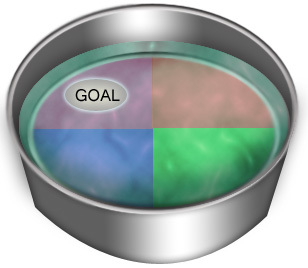| << Chapter < Page | Chapter >> Page > |
Spatial learning in general and MWM performance in particular appear to depend upon the coordinated action of different brain regions and neurotransmitter systems (D’Hooge, 2001). Gonadal hormones also seem to be responsible, in part, for behavioral sex differences, but their contribution varies greatly with the particular behavior (Beatty, 1979).

Males and females of most sexually reproductive species learn and retain information differently throughout their lives. These differences have been observed in many species, from invertebrates to humans. As discussed earlier, rats are a common test animal that we believe to exhibit behavior similar to humans. Thus, many of the assumptions we have about learning processes are based on experiments using rat models.
As discussed in the introduction and in [link] , males typically perform better on spatial learning tasks. Sex-differences in learning also occur in a variety of other learning paradigms. Dalla (2009b) focuses on classical and operant conditioning paradigms, including classical eyeblink conditioning, fear-conditioning, active avoidance and conditioned taste aversion. This chapter will explain each paradigm in detail and outline some of the more influential work done in the field. These sex-differences have been explained in terms of physiological, hormonal, and role differences between male and female rats.
The Classical Eyeblink Conditioning paradigm is a task which employs the denominated taxon strategy, and requires the learning of arbitrary associations between a set of stimuli and a set of responses. In most set-ups, animals are conditioned to blink following a sound, or conditioned stimulus. To teach this behavior, stimulation of the eyelid is given immediately following the noise and causes the animal to blink (unconditioned, automatic response). Over time, the subject learns to blink as soon as he hears the noise, regardless of whether the stimulation occurs. This is the conditioned response (Dalla, 2009b).
A variation of this procedure is trace conditioning in which the stimulus and response are separated by a longer interval of time. Trace conditioning is directly related to hippocampus activity (discussed later). Sex differences can also be observed through delay conditioning in which the conditioned stimulus and the conditioned response overlap and the response does not depend on the hippocampus (Dalla, 2009b).
During both trace and delay conditioning, females performed better than males. Females learn to blink with less training and, on average, blink more quickly after the conditioned stimulus than males. After a few days of training, however, both sexes reached the the same level of performance, suggesting that the sex difference is present in the learning process and not in the ultimate performance ability. Perhaps the most convincing evidence for female performance superiority in the CEC paradigm is that females that were trained and then re-exposed to the stimulus weeks later responded with the correct conditioned response more often than males did. Thus, females were able to retain information longer than their male counterparts (Dalla, 2009a).

Notification Switch
Would you like to follow the 'Mockingbird tales: readings in animal behavior' conversation and receive update notifications?